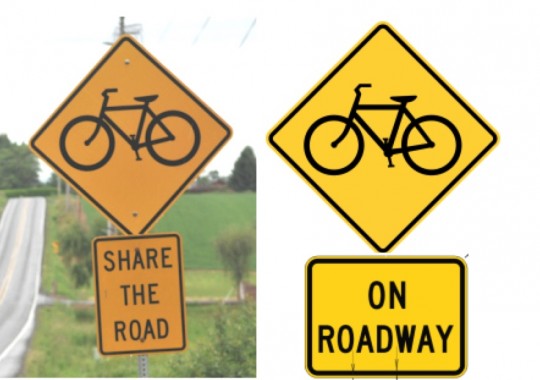
(Photo: J. Maus/BikePortland)
What does a “Share the Road” sign mean to you?
The State of Oregon has decided that those signs mean different things to different people so they’ve taken the step of officially phasing them out. Oregon isn’t the first state to do this. Delaware banished Share the Road signs in 2013 after that state’s advocacy group (Bike Delaware) made the case that its ambiguity “invites conflicting interpretations.”
In Oregon the effort to re-consider Share the Road signs came from within. Nastassja Pace with Travel Oregon and Oregon Parks’ Bicycle Recreation Specialist Alexandra Phillips were the ones who first brought the issue up to the transportation department. At a January 15th meeting of the Oregon Traffic Control Devices Committee, Phillips and ODOT’s Active Modes Engineer Gary Obery made an official proposal about the issue. According to minutes from that meeting, they said people who ride bikes felt the signs were confusing and other road users were misinterpreting the signs as “telling bikes to share the road.” (There’s also recent research that indicates the signs don’t work.)
The ODOT committee agreed that the current sign is confusing and decided to phase it out in favor of a sign that will show a bicycle symbol and have the words “On Roadway” beneath it.
Advertisement
Oregon’s new policy isn’t an outright ban on using Share the Road signs; but new state signage guidelines clearly state that “On Roadway” is the preferred option. Here’s the statement from ODOT Engineer Gary Obery:
“ODOT intends to use the ‘ON ROADWAY’ plaque instead of the ‘SHARE THE ROAD’ on new installations or replacement of installations that have reached the end of their useful life. The ‘SHARE THE ROAD’ plaque is still in the MUTCD [Manual on Uniform Traffic Control Devices, a federal guide] and is still available for ODOT or any other jurisdiction to use as may be appropriate, but the ‘ON ROADWAY’ plaque is now identified as the generally preferred option.”
The state’s official guidelines now say the “On Roadway” sign is preferred and is, “meant to remind motorists that bicycles may be present in the roadway.”
The signs are currently used across the state, mostly on rural roads where cycling is popular. Phillips manages Oregon’s Scenic Bikeway program. She said the issue first came up when her department was asked to install Share the Road signs on Scenic Bikeways. “I wanted to make sure we were using the best sign available,” she said. Phillips had also heard from colleagues in Bend who also said the signs were being misinterpreted by road users.
Reached today by phone, Bike Delaware Executive Director James Wilson said he’s pleased Oregon has followed his state’s lead. “Our state’s motto is ‘the first state’ but we didn’t want to be first and we certainly didn’t want to be the only state to do this.” Wilson says the trend to re-think the “Share the Road” mantra might present a challenge to bike advocates. “To the extent the bicyle movement has a national unifying slogan you could argue it’s ‘share the road'” he said. The dozens of states that have the phrase emblazoned on special license plates are a testament to this fact.
Oregon is one of those states. No word whether the slogan will be phased out of license plates next. “I imagine it’d be kind of awkward to remove it from the signs but still have it your plates,” Wilson said.
UPDATE, 2/26: Worth noting that the We Bike Eugene blog reported some of this story on February 4th. (Sorry Richard! I didn’t realize you wrote that post.)
— Jonathan Maus, (503) 706-8804 – jonathan@bikeportland.org
BikePortland can’t survive without paid subscribers. Please sign up today.



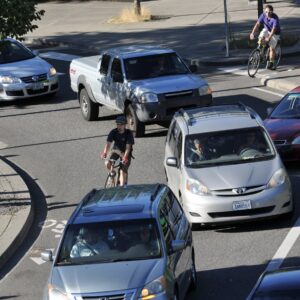
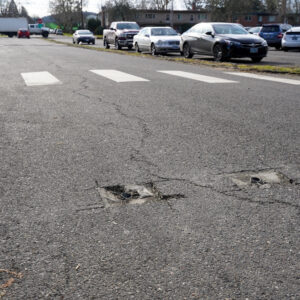
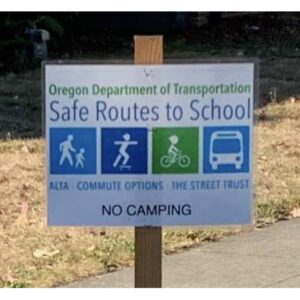
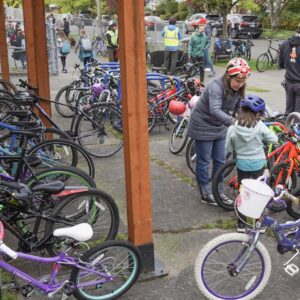
Thanks for reading.
BikePortland has served this community with independent community journalism since 2005. We rely on subscriptions from readers like you to survive. Your financial support is vital in keeping this valuable resource alive and well.
Please subscribe today to strengthen and expand our work.
Good on ODOT for removing these ambiguous signs from the standard. Motorists have frequently yelled at me to “share the road”, when they really meant to say “get out of my way”. It’s clear that sharing the road does not work.
Though, I disagree somewhat on the replacement sign: “bikes may use full lane” would be better than “bikes on roadway”.
Remember Adam that this change is really about rural roads where speeds are high. While I like the “use full lane” signs on urban areas where speeds are slower, I don’t agree with you that on rural roads we need signs suggesting that people on bicycles use the full lane.
Also worth noting that this new signage guideline for ODOT will also be used when caution is needed for other vehicles like tractors, fire engines, horse-drawn carriages and so on. All the vehicle signs listed in the MUTCD here can now be accompanied by “on roadway”.
Good point, I was not thinking about rural roads. On that point, I agree with you.
Where exactly do you think we should be riding on roads with nine to twelve foot travel lanes and zero to one foot shoulders? If you think there’s a place other than in the lane, I have to marvel at your tolerance for being unlawfully buzzed.
When the lane is too narrow for a motor vehicle to safely and legally pass a cyclist while remaining fully within the lane, it’s good riding practice to control the lane. State law FRAP exceptions include exactly this situation and national standards on just what that lane width is indicate fourteen feet.
On such roads the state standard signage absolutely should be “Bicycles may use Full Lane”. I’m really amazed that anyone who rides would oppose such a standard.
There was a time in the ’70s when I didn’t take the lane on such roads. After numerous unpleasant and dangerous encounters, I read up on the situation and adjusted my lane position. Half a million miles later, I cannot imagine riding any other way, although I do see people try. When I see them they are usually being buzzed.
People should ride where they are most comfortable riding because there is no empirical evidence that lane control decreases risk. After all, it is the duty of drivers to avoid hitting people cycling on the right, in the middle, on the shoulder, or on the sidewalk. Moreover, strident calls to ride in a VC manner perpetuate the myth that cycling is a high risk activity and discourages those who do not want to “control” traffic.
Jonathan,
Please google “bike crash Johnston County NC” about a crash that happened earlier this week in rural North Carolina. 4 bicyclists got mowed down by a driver precisely because they WEREN’T controlling the lane. Rural roads are the places where a Bikes May Use Full Lane sign is needed the most.
Or maybe they were mowed down because the driver operated dangerous machinery carelessly and/or recklessly.
At this point it appears the NC driver may have been incapacitated by previous mental problems and should not have been given a license, the “oncoming car” she saw and was swerving to avoid saw the wreck and stopped before reaching the wreck scene.
One point about using a full lane on a bike on rural roads. I know this makes sense in the city on narrow roads or at a red light. I’ve cycled rural roads and have met with some problems if I don’t stay about 1 1/2′ inward from the right side of the road. Staying that distance from the right side forces vehicles to pass you in the other lane [at least partially], especially on narrow roads. Vehicles passing other vehicles coming toward you is another reason to stay over toward the right. As far as semi’s and other huge trucks, I’ve found it best to pull off the road if they are going fast. Taking a whole lane on a rural road just makes drivers angry.
This is a good change, but I hope they don’t decide to make people change their existing car license plates. I have one of the “share the road” plates, and I’m somewhat abnormally attached to it, because it says, in four letters, “fuzzy effects.” Since I have more cats than I’ll admit to, all of my effects are fuzzy. Silly, I know, but it’s no fun being serious all the time!
Ours says ‘EQUIFY’. Which is not a word, and we’re not sure what it means, but we really like it.
Nice work ODOT and Travel Oregon!
Like many other folks, I’ve never liked the “share the road” signs. Especially with the visual depiction of a car and a bicycle side by side when the sign is usually installed in a location where side-by-side sharing is uniquely dangerous.
And I’ve always liked Oregon’s “bicycle on roadway” sign. Very straightforward. Both interpretations both mean bikes are expected to be on the road itself (either as a “warning to car drivers” or as a “directive to bicycle riders”).
And I think the Oregon sign predate the “share the road” sign anyway. Just goes to show that not all signage changes that pass the MUTCD review panel are the best signs to use, or the best signs available.
If anyone has skinny stretches of roadway where bicycling is not safe due to car drivers not giving enough space to folks on bikes, now is a good time to send in requests for “bicycle on roadway” signs. To safe@portlandoregon.gov or the hotline for whatever jurisdiction the road falls into.
Ted Buehler
Agreed. “Bikes may use full lane” is permissive and helps remind both drivers and people cycling about what the law states. “Bikes on roadway” serves no purpose to the person cycling (they already know they are on the roadway) and tells the driver nothing about what the law states regarding use of the road by people cycling.
Inside the built-up area, “may use full lane” makes more sense. However, as Jonathan pointed out above, riding in the middle of the lane on a 55 MPH rural road may not be the best idea.
Yes – this change is moving into the correct direction.
[There was a lot of initial hope in the “share the road” message 20 years ago in the bikes as transport advocacy community…]
PS. For high bike traffic rural highways with high speed traffic…I would love ODoT (and WADoT etc.) to also take the next step and consider adding:
– bike stencils on paved hard shoulders (reminding drivers of bike traffic); and
– bike crossing signs/ sharks teeth on highway ramps.
This could be a great PR and safety effort if tied to the currently planned ODoT effort to raise posted speeds along some rural highways.
No, no, and no. Stencils would just turn shoulders which are optional to ride in under the law into de-facto bike lanes which motorists and law-enforcement sees cyclists as REQUIRED to use. Would cause much more conflict with both. If anything I’d like to see any rural road that’s either a scenic bikeway on listed as most suitable on any state or local bike map have stencils every quarter mile IN the travel lane as a reminder of where they may encounter cyclists.
Living in Wa. Co. I’ve encountered frequent share the lane “quoters” in vehicles. If it happens at a stop I shut them down 100% off the time asking if the signs with deer on them are to tell them where to cross then.
per the ‘no, no, no’…there would a minimum design requirement for the shoulder dimension…I understand your concern about narrow substandard shoulders becoming “obligatory” bike lanes if stenciled.
How about a picture of bicycle and “please don’t kill me” lower case. Make a sign like that. Or just let me fly under the radar.
I ride rural roads where the speed limit is largely 35 mph, but most cars do 50 and some do more. In Cowlitz County we have some very low volume roads, but I don’t want tire tracks on my back. Keep you silly signs. Thanks.
“May use full lane”? AT MY OWN RISK. Who cares if I’m right if I’m dead? You what to spread cycling hated madness. Use the full lane.
Shouldn’t it be “Travelway” instead of roadway. Cops have been known to give tickets for not being to the right of the fog line. Travelway would make it more clear that you can be to the left of the fog line.
The roadway is the portion of the road between the fog lines. The road includes the shoulder area outside the fog lines. Therefore, bikes on roadway means just what your proposed bikes on travelway means.
If you have local cops who don’t know this, I suggest you print out the relevant portions of the vehicle code and carry it with you so you can quote them chapter and verse. I’ve had to quote a few portions of the vehicle code to ignorant state troopers in the past. I’m generally polite enough about it that we part on friendly terms and they thank me for the education, after they look up what I told them in their little code book.
No. Making up new words doesn’t solve the problem of cops (or citizens) who don’t know the law.
How many cyclists out there think “as far right as practicable” means to the edge of the pavement? A lot.
In Oregon, “Roadway” is defined as the area normally used for vehicular travel, exclusive of the shoulders, so since these signs are only used where the shoulder is too narrow for people to ride on, and people will be riding to the left of any fog line, “Roadway” seems appropriate.
Good move, Share the road is an “ask”, On road is a “tell” as it should be.
When Oregon had one too many cops hit by passing cars, it changed the law regarding passing distance for stopped emergency vehicles. One must now either slow to 35 mph or change lanes. Within months of that law change, signs went up on roadways all over the state informing motorists of the change.
For eight years now, we have had a law on the books regarding passing distance for motorists overtaking cyclists on those narrow suburban and rural roads where speed limits are over 35 mph and lane widths/shoulders are narrow, ORS 811.065. It is completely unenforced, as far as I know, and no signs have ever gone up to inform motorists of their duties when overtaking cyclists.
I’d much rather see signs informing motorists of their duties to give cyclists room to fall in their direction when passing on roads without bike lanes than “Bikes on Roadway” signs. Unfortunately, our spilled blood isn’t important enough to clutter up the roadway with informative signage.
I’ve lost track of the number of people who thought “share the road” was an instruction to cyclists (to yield to overtaking traffic).
Glad that it’s gone.
How about ditching “may” and have the signs reads “bicycles in the lane”. The “May”is too passive. and for those times where a driver passes a rider riding to the right of the lane or on the shoulder, the encounter would seem more pleasant to the driver since the rider would seem to be more accommodating by not taking the full lane- which the signage says is permissible. and yet gives the rider to the choice to pick lane position as well.
The vagueness of signage using words like “may” just seems kind of wishy-washy and can be left for interpretation (like as far to the right as possible).
I see people riding on sidewalks all the time in PDX so I think may is entirely appropriate.
Cool, but how about the replacement plaque saying something more useful like ‘Pass in Opposing Lane’ or ‘Pass with 5 Feet’ or something like that? Oregon probably won’t ever have a passing law that makes sense to drivers, so an advisory campaign to drive courteously will be needed, with an easy-to-remember rule for how to pass a bike but not be a dick about it.
Hopefully the new sign will be on the St. Johns bridge soon. The sharrows markers only last a few weeks.
Funny. I have always interpreted it as a plea for civility. Almost a throwback to a more orderly and cooperative mentality on the roads. But after seeing the new one, I have to concede it was gutless and ambiguous. The new one is more blunt.
Need BMUFL signs. The “bikes in roadway” sign is not going to help at all. It’s still going to be interpreted by territorial motorists as “stay out of my way”. The right to ride on the road has to be made explicit and undeniable which was always the problem with “share the road” signs because they did not do that.
My reasoning for asking for the sign change is that signs on the road are instructional. Bikes on Roadway is instructional. Share the Road is really a slogan and belongs on license and other places slogans appear. I think Share the Road definitely has a place, jut not on road signs.
Tell that to tractor drivers…
Share the road means different things to different people. Like to the driver who passes dangerously close and yells “share the road” – it means, “get off my road or I have the right to kill you”.
Bikes in roadway is at least a warning that bikes may be in the road.
Of course warning signs like “rough road” and “rocks in roadway” are intended to reduce ODOTs liability if someone hits a rough patch or rock.
The “Bikes must use full lane” signs are now standard practice on the Blue Ridge Parkway and Natchez Trace Parkway, and I understand they work very well on those National Park Service-maintained roads. Rails to Trails Conservancy encouraged them to use them as an experiment a couple of years ago. Now there is talk of installing them on roads within the National Parks system (Yellowstone, etc.). Perhaps Oregon State Parks, county and local parks, and Metro might consider following suit.
It’s an improvement, I’ll take it!
I’ve always associated “Bikes in roadway” signs with places where bike lanes or sidewalks end and there is nowhere else to ride. For example, on a narrow bridge or through a tunnel.
Is there a risk that a more widespread use of “Bikes in roadway” signs might give some motorists the impression that bikes don’t belong on roads where the signs are absent?